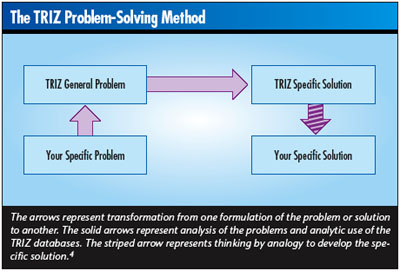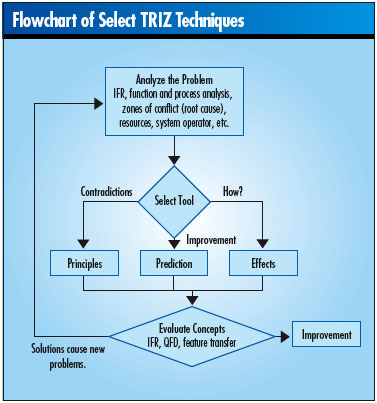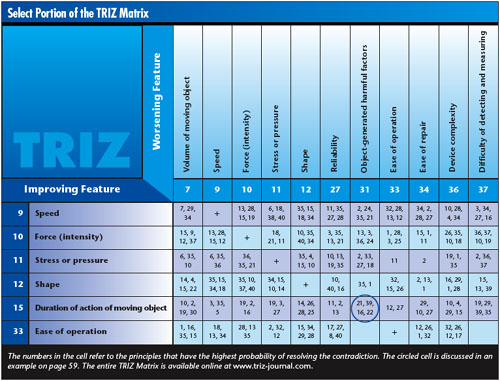| by Ellen Domb, Ph.D.
Six Sigma projects of all kinds frequently reach a point
where the analysis is done but the next step remains unclear.
In order to figure out what to do next, the project team
must employ those brainstorming and related process-improvement
tools recommended by Six Sigma and other methods, such
as total quality management and quality circles. However,
many of these tools depend on intuition and team members’ knowledge,
neither of which is reliable in a strictly scientific sense.1
Between 1946 and 1985, the Russian scientist G.S. Altshuller
and his colleagues developed a theory of inventive problem
solving known by the Russian acronym “TRIZ.” Based
on logic and data rather than intuition, TRIZ accelerates
a project team’s ability to solve problems. TRIZ
relies on the study of problem-and-solution patterns, not
an individual’s or group’s spontaneous creativity.
To develop the theory, Altshuller and his colleagues
analyzed more than 400,000 patents to discover the patterns
that predict breakthrough solutions to problems. TRIZ research
began with the hypothesis that universal principles of
invention underlie the creative innovations that advance
technology. Once these principles are identified and codified,
they can be taught and will help make the process of invention
more predictable.
Two basic truths in the TRIZ doctrine maintain that:
 Somebody, someplace, has already solved any problem--or
one very similar to it. Somebody, someplace, has already solved any problem--or
one very similar to it.
 Creativity
means finding that solution and adapting it to a current
problem. Creativity
means finding that solution and adapting it to a current
problem.
The research has proceeded in several stages. Four primary
findings indicate that:
 Problems
and solutions are repeated across industries and sciences. Problems
and solutions are repeated across industries and sciences.
 Classifying
the contradictions in a given problem makes it possible
to predict creative solutions to that problem. Classifying
the contradictions in a given problem makes it possible
to predict creative solutions to that problem.
 Patterns of technical evolution are repeated across
industries and sciences. Patterns of technical evolution are repeated across
industries and sciences.
 Creative innovations use scientific effects outside
the field in which they were developed.2 Creative innovations use scientific effects outside
the field in which they were developed.2

The practice of TRIZ consists of identifying problem-solving
patterns, identifying patterns of technical evolution,
identifying methods of using scientific effects, and applying
them to a specific situation confronting the developer,
as illustrated on page 56.
A powerful demonstration of this method can be found
in the pharmaceutical industry. Tailored bacteria are used
to cultivate human hormones, producing a superior product
to those refined from animal sources. To produce the hormone,
though, large quantities of tailored bacteria cells must
be cultured, the cells broken open and the cell walls removed.
A mechanical method for breaking the cells produced an
80-percent yield, but it was variable at best.3 More recently,
the yield had fallen to 65 percent; the pharmaceutical
industry wished to increase production to much higher yields.
The problem from a TRIZ standpoint is to find a way to
produce the product with no waste, at 100 percent yield
and without new complications. TRIZ theory states, “The
problem should solve itself.” A generic TRIZ solution,
based on patterns of technical evolution, replaces mechanical
devices with fields. This may seem very general, but it
led pharmaceutical researchers to analyze all the resources
available in the problem (e.g., the cells, cell walls,
surrounding fluid and its motion, the processing facility,
etc.). They concluded that three
specific solutions had high potentials for solving the
problem:
 Cell walls could be broken by sound waves. Cell walls could be broken by sound waves.
 Cell walls could be sheared open as they pass through
the processing facility. Cell walls could be sheared open as they pass through
the processing facility.
 An enzyme in the fluid could “eat” cell
walls and release the contents at the desired time. An enzyme in the fluid could “eat” cell
walls and release the contents at the desired time.
All three methods had been tested successfully, and the
least expensive, highest-yield method was soon in production.
The general TRIZ solutions referred to on page 60 have
been developed during 65 years of research and organized
in many different ways. These include analytic methods
such as:
 Ideal final result Ideal final result
 Functional analysis and trimming Functional analysis and trimming
 Locating zones of conflict (known to Six Sigma problem
solvers as root cause analysis) Locating zones of conflict (known to Six Sigma problem
solvers as root cause analysis)
Other solutions are more prescriptive and include:
 The 40 principles of problem solving The 40 principles of problem solving
 Separation principles Separation principles
 Laws of technical evolution and technology forecasting Laws of technical evolution and technology forecasting
When solving any technical problem, one tool or many
can be used. The flowchart below illustrates
this.

The 40 principles of problem solving are TRIZ’s
most accessible “tool.”5 These principles repeat
across many fields as solutions to many general contradictions.
They also lie at the heart of many Six Sigma problems.
According to TRIZ methodology, contradictions should be
eliminated. The methodology recognizes two categories of
contradictions:
 Technical contradictions. These are the classical engineering
tradeoffs in which the desired state can’t be reached
because something else in the system prevents it. In other
words, when something gets better, something else gets
worse. Examples of technical contradictions include the
following: Technical contradictions. These are the classical engineering
tradeoffs in which the desired state can’t be reached
because something else in the system prevents it. In other
words, when something gets better, something else gets
worse. Examples of technical contradictions include the
following:
- Product gets stronger (i.e., good), but the weight
increases (i.e., bad).
- Bandwidth increases (good) but requires more power
(bad).
- Service is customized to each customer (good), but
the service delivery system becomes complicated (bad).
- Automobile airbags deploy quickly to protect
the passenger (good), but the faster they deploy, the
more
likely they will injure or kill small or out-of-position
people (bad).
 Physical contradictions. Also called “inherent” contradictions,
these include situations in which one object or system
has contradictory, opposite requirements. Everyday examples
abound: Physical contradictions. Also called “inherent” contradictions,
these include situations in which one object or system
has contradictory, opposite requirements. Everyday examples
abound:
- Surveillance aircraft should fly fast to their destinations,
but also slowly to collect data over the target.
- Software should be easy to use but include many complex
features and options.
- Coffee should be hot for enjoyable drinking but cool
enough to prevent burning consumers.
- Training should be thorough but not take any time.
- Airbags must inflate both quickly and slowly.
TRIZ includes 40 principles for solving technical/tradeoff
contradictions and four separation principles for solving
physical/inherent contradictions. Many problems
can be stated as both physical and technical contradictions.
In general, the most comprehensive solutions come from
the physical contradiction formulation, whereas the most
prescriptive solutions derive from the technical contradictions.
People usually learn to solve technical contradictions
first because the method is very concrete. Afterward, they
learn to solve physical contradictions, then use both methods
interchangeably,
depending on the problem.
TRIZ research has classified 39 features for technical
contradictions. Once a contradiction is expressed in the
technical form (i.e., the tradeoff), the next step is to
locate specific features in the contradiction matrix.6 The
figure on below shows a piece of the matrix.

To use the matrix, find the row that most closely matches
the feature or parameter you’re improving in your
tradeoff and then the column that most closely matches
the feature or parameter that degrades it. The cell at
the intersection of that row and column will have several
numbers. These identify specific principles of invention
that are most likely to solve the problem, that is, to
lead to a breakthrough solution instead of a tradeoff.
For example, consider the proposal to change airbag inflation
speed to reduce injuries to small occupants. The tradeoff
is that injuries in high-speed accidents increase. Translating
this into TRIZ matrix terms, the parameter that improves
is “duration of action of a moving object” (row
15) and the parameter that worsens is “object-generated
harmful factors” (column 31). The circle in the figure
highlights the cell at the intersection and includes the
numbers 21, 39, 16 and 22. These are identifiers for four
principles of invention.
Usually the principles are accompanied by examples from
a variety of industries. The design or problem-solving
team uses the text, those examples and examples from its
own previous applications to develop a solution.
Consider the application of principle 21 to the airbag
example:
 Principle 21: Skipping. Conduct a process or certain
stages of it (e.g., destructible, harmful or hazardous
operations) at high speed. For example: Principle 21: Skipping. Conduct a process or certain
stages of it (e.g., destructible, harmful or hazardous
operations) at high speed. For example:
- Use a high-speed dentist’s drill to avoid heating
tissue.
- Cut plastic faster than heat can propagate in the
material to avoid deforming the shape.
One solution to the airbag problem, then, would be to
inflate the bag faster than current practice, so that it’s
fully inflated when it impacts a small person. The “depowered” air
bag has been proposed as a solution of this type. By using
less power, the bag’s acceleration is less and injuries
will be reduced. Conversely, smaller bags with higher power
would reach full inflation sooner so that passengers would
be protected from accidents and not injured by the bag.
TRIZ outlines four ways to resolve physical or inherent
contradictions:
 Separation in time Separation in time
 Separation in space Separation in space
 Coexistence of contradictory properties in different
subsystems Coexistence of contradictory properties in different
subsystems
 Move
the problem to the super- or subsystem Move
the problem to the super- or subsystem
A very common Six Sigma transactional problem can be
expressed as an inherent contradiction: We want everyone
to understand all the Six Sigma methods so we can improve
all our processes, but we don’t want everyone to
stop working for the time required for training. In other
words, we want both a lot of training and no training.
Examining the separation principles, we see possible
solutions in all of them. For example, separation in time
suggests training Black Belts first, then having Black
Belts train other employees while working on projects.
TRIZ was developed from the study of patents, but the
underlying creative principles discovered apply to a wide
variety of transactional and product problems. Recent case
studies of actual situations include the following:
 Transportation. Singapore needed to find a way to manage
automobile traffic on the Sentosa, the city’s entertainment
island. Applications of TRIZ methods developed eight families
of solutions.7 Transportation. Singapore needed to find a way to manage
automobile traffic on the Sentosa, the city’s entertainment
island. Applications of TRIZ methods developed eight families
of solutions.7
 IT product development. DelCor Interactives International
doubled the value to the customer of its patient interview
system for optical offices. The company applied TRIZ feedback
and self-service principles8 to overall product
development. It also applied the principles of segmentation
(i.e., “taking
out” and “composite construction”) to
training and support. IT product development. DelCor Interactives International
doubled the value to the customer of its patient interview
system for optical offices. The company applied TRIZ feedback
and self-service principles8 to overall product
development. It also applied the principles of segmentation
(i.e., “taking
out” and “composite construction”) to
training and support.
 Education. School administrators are enhancing their
creativity in dealing with situations ranging from allocating
budget for special education to building five schools using
funds for four, to improving racial harmony.9 Education. School administrators are enhancing their
creativity in dealing with situations ranging from allocating
budget for special education to building five schools using
funds for four, to improving racial harmony.9
 Waste processing. Dairy farm operators could no longer
dry cow manure due to increased energy costs. TRIZ identified
the method used for concentrating fruit juice, which requires
no heat.10 Waste processing. Dairy farm operators could no longer
dry cow manure due to increased energy costs. TRIZ identified
the method used for concentrating fruit juice, which requires
no heat.10
 Warranty cost reduction. Ford Motor Co. used TRIZ to
solve a persistent problem with squeaky windshields that
cost several million dollars each year.11 Previously,
the manufacturer used TRIZ to reduce idle vibration in
a small
car to less than one-third the initial value.12 Warranty cost reduction. Ford Motor Co. used TRIZ to
solve a persistent problem with squeaky windshields that
cost several million dollars each year.11 Previously,
the manufacturer used TRIZ to reduce idle vibration in
a small
car to less than one-third the initial value.12
Additionally, TRIZ works well with Six Sigma. As with
other tools in that methodology, TRIZ is procedural; it
can be used by individuals or teams, and helpful case studies
abound. The best way to explore TRIZ is to start with a
problem you haven’t solved satisfactorily and apply
these effective methods to it.
Ellen Domb, Ph.D., is the editor of The TRIZ Journal,
an online publication available at www.triz-journal.com,
and the principal TRIZ consultant for the PQR Group in
Upland, California. TRIZ is Domb’s sixth career:
She has been a physics professor, an aerospace engineer,
an engineering manager, a product-line general manager
and a strategic planning/quality improvement consultant.
References
1. Smith, Larry. 2001. www.asq.org/pub/sixsigma/past/vol1_issue1/evolution.html
Tennant, Geoff. 2003. “TRIZ for Six Sigma.” www.sixsigmatriz.com
2. Altshuller, Genrich. 1988. Translated by Anthony Williams.
Creativity as an Exact Science. Gordon and Breach, New
York.
3. Anderson, Wesley, Justin Farrell, and Karen Tate. 1997. “TRIZ
Applied to Solving Manufacturing Problems and Improvement.” Proceedings
of the third Annual International Total Product Development
Symposium, American Supplier Institute, Livonia, MI.
4. Rantanen, Kalevi, and Ellen Domb. 2002. Simplified
TRIZ. CRC Press, Boca Raton, Florida.
5. Domb, Ellen. 1997–2003. “Tutorial on
Contradictions.” The TRIZ Journal, www.triz-journal.com,
July 1997.
Altshuller, Genrich. 1988. Translated by Anthony Williams.
Creativity as an Exact Science. Gordon and Breach, New
York.
6. Domb, Ellen. 1997–2003. “Tutorial on
Contradictions” The TRIZ Journal, July, 1997.
Mann, Darrel, and Ellen Domb. “40 Principles for
Business, with Examples.” The TRIZ Journal, September
1999.
7. Zhang, Jun, Tan Kay-Chuan, and Chai Kah-Hin. “Systematic
Innovation In Service Design Through TRIZ.” The TRIZ
Journal, September 2003.
8. Domb, Ellen, and David Corbin. 1998. “QFD, TRIZ
and Entrepreneurial Initiative.” Proceedings of the
10th Quality Function Deployment Symposium, Novi, MI. Reprinted
in The TRIZ Journal, September 1998.
9. Hooper, Don, Kathy Aaron, Holly Dale, and Ellen Domb.
1998. “TRIZ in School District Administration.” The
TRIZ Journal, February 1998.
10. Raskin, Andy. 2003. “A Higher Plane of Problem
Solving.” Business 2.0 Magazine, June 2003.
11. Lynch, Michael. 1997. “Windshield/Backlight
Molding Squeak and Flutter (Buzz) Problem.” Proceedings
of the third Annual International Total Product Development
Symposium, American Supplier Institute, Livonia, MI. Reprinted
in The TRIZ Journal, January 1998.
12. Smith, Larry. 1996. “Using TRIZ to Reduce Vibration
During Idling.” Proceedings of the 12th Annual GOAL/QPC
Symposium, GOAL/QPC. Methuen, MA.
|